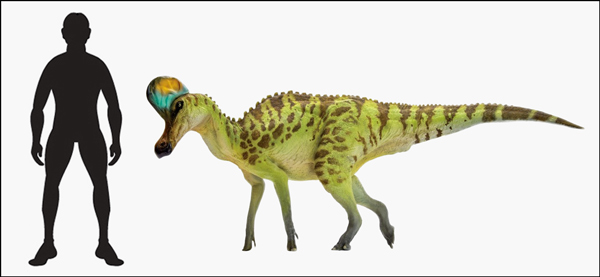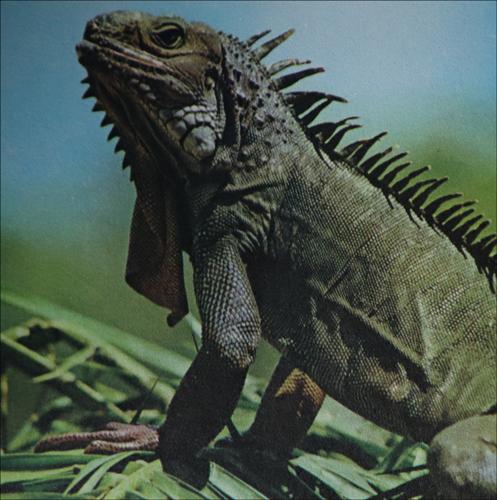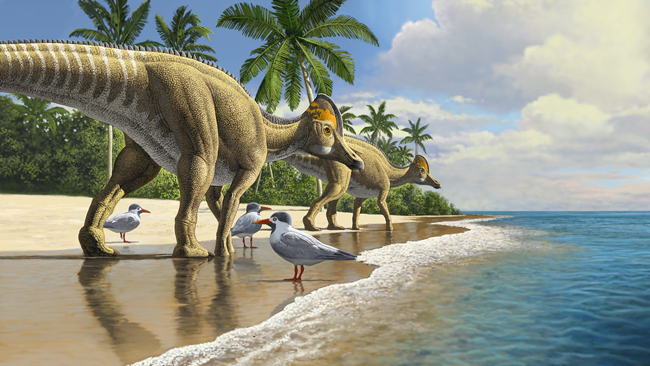The First Duckbill from Africa
Fragmentary fossils including parts of a jawbone have led an international team of scientists to announce the discovery of a new species of dinosaur from the Late Cretaceous of Morocco. A number of dinosaurs have been described from the marine sediments that comprise the economically important phosphate deposits associated with the Ouled Abdoun Basin of north-central Morocco, but this new discovery is of particular significance. These are the first fossils of a hadrosaur known from Africa and it suggests that these duck-billed dinosaurs were capable of crossing hundreds of miles of open ocean to reach new habitats. The lambeosaurine dinosaur has been named Ajnabia odysseus.
A Life Reconstruction of the Newly Described Lambeosaurine Ajnabia odysseus
Picture credit: Raul Martin
Ajnabia odysseus – A Lambeosaurine Hadrosaur
The genus name means stranger or foreigner in Arabic, a reference to the fact that these ornithischian dinosaurs were not known from Africa. The species name is a reference to Odysseus the sea-faring hero of Homer’s epic poem “Odyssey”. The researchers which include Dr Nicholas Longrich (University of Bath) and Professor Nour-Eddine Jalil from the Department of Geology (FSSM), at the University Cadi Ayyad (Morocco), comment that this dinosaur lived about a million years before the end-Cretaceous extinction event (Late Maastrichtian).
A phylogenetic assessment suggests that Ajnabia was closely related to European hadrosaurs (the Arenysaurini, a clade of lambeosaurines previously known only from France and Spain).
The teeth and jawbone permitted the scientists to assign it to the lambeosaurine branch of the Hadrosauridae, a group of duck-billed dinosaurs famed for their elaborate and ornate hollow crests. It is very likely that the lambeosaurine dinosaurs evolved in North America and then spread into Asia via a northern land bridge before moving into Europe and finally crossing deep and wide seas to reach North Africa.
The specimen suggests that this dinosaur was a dwarf when compared to its more famous and geologically older relatives from North America such as Corythosaurus, Parasaurolophus and Lambeosaurus. The research team estimate the Ajnabia was around three metres long.
A Scale Drawing of the Newly Described Moroccan Lambeosaurine A. odysseus

Picture credit: Everything Dinosaur
Distinct Dinosaur Dominated Terrestrial Faunas
By the Late Cretaceous distinct dinosaur dominated terrestrial faunas had been established in the Northern and Southern Hemispheres. This had been driven by the continued break-up of the landmass that once was the super-continent Pangaea, the widening of the Atlantic and a rise in global sea levels.
The Northern Hemisphere dinosaur biota was characterised by duck-billed dinosaurs, the Ceratopsia (horned dinosaurs) with tyrannosaurids occupying the niche of apex predators.
The Southern Hemisphere dinosaur biota was characterised by the continuation of the titanosaurian sauropods with members of the Abelisauridae as top predators.
The scientists conclude that hadrosaurs must have crossed hundreds of miles of ocean to rich Africa. These plant-eating dinosaurs with their powerful, deep tails were very probably capable swimmers so such feats may not have been beyond them. After all the estuarine crocodile (Crocodylus porosus), has been known to cross wide stretches of open water and has been spotted far out to sea.
Perhaps, dinosaurs were swept out to sea on rafts of vegetation following a storm event, which permitted them to colonise new habitats.
A Modern Analogy – Iguanas on the Island of Anguilla
Green iguanas were found to be living on the Caribbean island of Anguilla when they had not been reported from the island before. Biologists concluded that hurricanes in 1995 had led to trees that originated in Guadaloupe some two hundred miles to the south-east of Anguilla, where the iguanas are indigenous, being washed ashore. It is thought that a group of these reptiles drifted out to sea and after about three weeks, the trees, with their unintentional lizard cargo made landfall on the island.
An Unlikely Seafarer – An Iguana

Picture credit: Everything Dinosaur
Dr Longrich commented:
“Over millions of years, once-in-a-century events are likely to happen many times. Ocean crossings are needed to explain how lemurs and hippos got to Madagascar, or how monkeys and rodents crossed from Africa to South America.”
Ajnabia odysseus Colonised New Territories
Writing in the academic journal “Cretaceous Research”, the scientists conclude that as there were extensive and long-lasting seaways separating Africa and Europe from other landmasses and in the absence of any evidence for a two-way faunal interchange characterised by land bridges, it is likely that some animals were able to colonise new territories either by swimming to them or perhaps by being castaways. Such patterns of dispersal are seen with both extant or ancestral forms of mammals, reptiles and amphibians. This newly published paper suggests that dinosaurs too, were capable of travelling across oceans.
Dr Longrich added:
“As far as I know, we are the first to suggest ocean crossings for dinosaurs.”
Co-author Professor Nour-Eddine Jalil summarised the importance of this fossil find from a Moroccan phosphate mine by stating:
“The succession of improbable events (crossing an ocean by a dinosaur, fossilisation of a terrestrial animal in a marine environment) highlights the rarity of our find and therefore its importance. Ajnabia shows us that hadrosaurs have set foot on African land, telling us that ocean barriers are not always an insurmountable obstacle.”
The scientific paper: “The first duckbill dinosaur (Hadrosauridae: Lambeosaurinae) from Africa and the role of oceanic dispersal in dinosaur biogeography” by Nicholas R. Longrich, Xabier Pereda Suberbiola, R. Alexander Pyron and Nour-Eddine Jalil, published in Cretaceous Research.
Visit the Everything Dinosaur website: Everything Dinosaur.







Leave A Comment